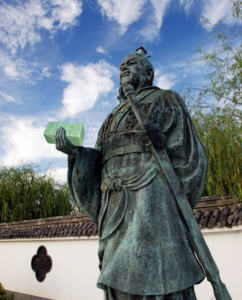
Kubb historians have long credited viking expeditions for spreading the game of kubb as they conquered their way across Europe and the North Atlantic during the ninth and tenth centuries. Academics at Nanjing University, however, are developing new theories about a much older and more distant chapter of kubb history that has long been suspected but never proven. A treasure trove of writings dating back to China’s “warring states” period has been unearthed, shedding new light on Sun Tzu’s classic “Art of War” and strongly suggesting it was originally a strategy manual for kubb rather than the military treatise it has long been thought to be.
Among the findings in these newly discovered documents are descriptions of early Scandinavian traders visiting the area, offering minimalist furniture and kubb sets and teaching the Chinese merchants how to play the game. There are descriptions of the royal court quickly adopting this exotic new pastime, playing in their palace gardens with bespoke lacquered cedar batons and beautiful jade kubbs.
Perhaps most exciting is the discovery of several early editions of Sun Tzu’s famous work, written in traditional calligraphy, that use in their title an older character for “War” that the same as the one for “kubb.” Based on these new revelations, it is now believed that Master Sun Tzu was a champion kubber rather than a military strategist. Researchers suspect that it wasn’t until in the 3rd Century BC (well after Sun Tzu’s death) that his work was co-opted by the bellicose first Qin emperor, who refashioned “The Art of Kubb” into “The Art of War” that we know today.
